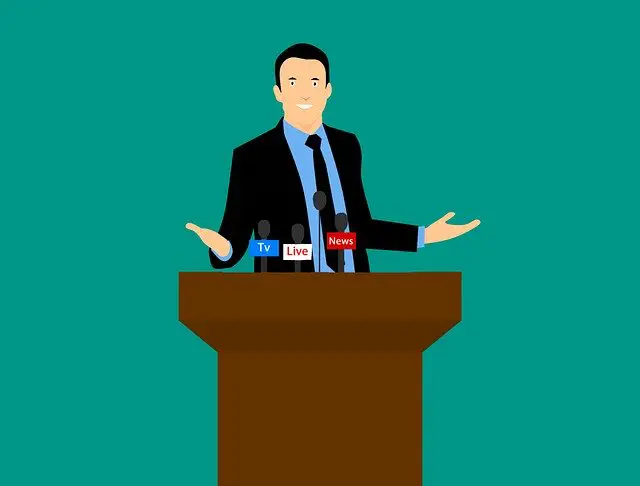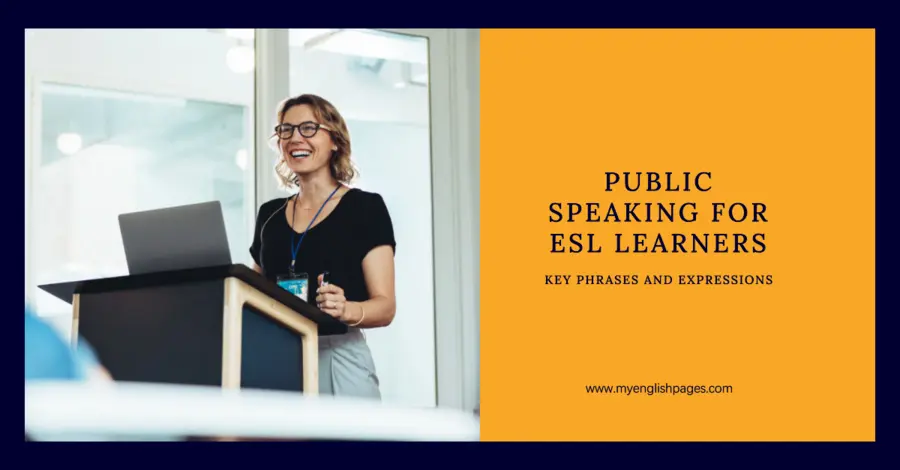Table of Contents
Public speaking can be challenging for anyone, especially if English is not your first language. But with the right phrases and expressions, you can confidently deliver speeches, presentations, or talks. This guide is designed to help ESL learners master public speaking key phrases, best opening words for presentations, and useful speech introduction greeting examples to impress your audience from the very start.
Why Learning Public Speaking Phrases Matters for ESL Learners
Public speaking is not only about what you say but also how you say it. Using clear, appropriate expressions will help you:
- Capture your audience’s attention
- Organize your ideas smoothly
- Sound natural and confident
- Avoid awkward pauses and fillers
Public Speaking Key Phrases

Public speaking can feel overwhelming, especially when English isn’t your first language. But knowing the right phrases can make a huge difference in how confidently and clearly you communicate. Below, we’ve organized some of the most useful public speaking key phrases into clear sections
The following section focuses on some of the most important public speaking expressions
Best Opening Words for Presentation
The opening of your presentation sets the tone. Here are some strong ways to begin:
Greeting the Audience
- Good morning/afternoon/evening everyone.
- Hello everyone, thank you for being here today.
- Welcome, and thank you for joining me/us.
- Hi everyone, I’m happy to see you all here today.
- It’s great to have you all here; thank you for coming.
- I appreciate you all taking the time to be here with me today.
Introducing the Topic
- Today, I’m going to talk about…
- The topic of my presentation is…
- Let’s start by looking at…
- I’d like to begin by discussing…
- My focus today will be on…
- What I want to share with you today is…
- I’m here today to explain…
Grabbing Attention
- Have you ever wondered…?
- Imagine a world where…
- I’d like to begin with a question…
- Let me tell you a short story…
- Picture this situation…
- Did you know that…?
- Here’s an interesting fact…
Speech Introduction Greeting Examples
When starting a speech, a polite and warm greeting can engage your listeners:
- Ladies and gentlemen, thank you for this opportunity to speak with you.
- It’s a pleasure to be here today to discuss…
- I’m honored to speak about a subject that’s very important to me…
- Thank you all for coming. Today, I want to share with you…
- Good [morning/afternoon/evening], it’s wonderful to see so many familiar faces here today.
- I’m delighted to have the chance to talk with you about…
- I truly appreciate the invitation to speak with you all today.
Public Speaking Key Phrases for Different Parts of Your Speech
Transition Phrases
- Moving on to the next point…
- Let’s now look at…
- Another important aspect is…
- On the other hand…
- Now, let’s turn our attention to…
- This leads us to the next topic…
- Let’s shift gears and explore…
Giving Examples
- For example…
- Such as…
- To illustrate this point…
- A good example is…
- For instance…
- Let me give you an example…
- Take, for example, the case of…
Emphasizing Points
- It’s important to note that…
- I want to highlight…
- What I mean is…
- Keep in mind that…
- I’d like to stress that…
- Let me emphasize this point…
- I want to make it clear that…
Summarizing or Concluding
- To sum up…
- In conclusion…
- Finally, I want to say…
- To wrap things up…
- In summary…
- Let me leave you with this final thought…
- Thank you for your attention.
Bonus: Useful Expressions for Handling Questions
- That’s a great question.
- I’m glad you asked that.
- Let me explain…
- I don’t have the answer right now, but I will find out and get back to you.
- That’s an interesting point; let me clarify.
- Thank you for bringing that up.
- I appreciate your question; here’s what I can tell you.
After exploring important public speaking terms, let’s transition to some crucial tips to ace your presentation.
Tips for ESL Learners to Improve Public Speaking

Public speaking in English can be challenging, but with practice and the right strategies, you can become more confident and effective. Here are some public speaking tips for ESL learners:
1. General Tips for ESL Learners
- Practice these phrases out loud regularly. Repetition helps improve fluency and reduces nervousness.
- Record yourself and listen to improve pronunciation. Hearing your own voice can help you spot areas for improvement.
- Start small: practice in front of friends or family. This creates a safe environment to build your confidence.
- Use simple language — clarity is better than complexity. Don’t worry about fancy vocabulary; focus on getting your message across clearly.
- Watch English presentations online to learn natural speech patterns. TED Talks, YouTube presentations, and speeches can be great resources.
2. Tips to Structure Public Speaking
- Plan your speech in clear sections: introduction, main points, and conclusion. This helps your audience follow your ideas easily.
- Use transition phrases to connect ideas smoothly. Phrases like “moving on to…” or “another important point is…” guide listeners through your speech.
- Practice your opening and closing lines until you feel comfortable. A strong start grabs attention, and a clear conclusion leaves a lasting impression.
- Keep your speech focused and avoid going off-topic. This makes your presentation more engaging and easier to understand.
3. Tips on Using Body Language
- Maintain eye contact with your audience. It shows confidence and helps build a connection.
- Use natural hand gestures to emphasize key points. Gestures can help make your message more memorable.
- Stand or sit up straight to project confidence. Good posture improves your voice projection and audience perception.
- Move around the stage or space moderately. Avoid pacing too much but don’t stay rigidly still — movement can help keep your audience engaged.
- Smile when appropriate. It makes you appear friendly and approachable.
FAQs about Public Speaking Key Phrases
What are the 5 P’s of public speaking?
The 5 P’s of public speaking are a helpful way to remember key preparation steps:
– Prepare – Research your topic and organize your ideas clearly.
– Practice – Rehearse your speech multiple times to build confidence.
– Passion – Show enthusiasm for your topic to engage the audience.
– Pace – Speak at a comfortable speed, not too fast or slow.
– Projection – Use a clear, strong voice so everyone can hear you.
What are the 4 P’s of public speaking?
Sometimes the focus is on four main P’s:
– Preparation – Planning your content and practicing.
– Practice – Rehearsing your speech aloud.
– Performance – Delivering your speech with confidence and energy.
What are keywords in public speaking?
In public speaking, keywords are important words or phrases that summarize your main ideas. They help you stay on track, remind your audience of key points, and make your speech easier to follow. Using keywords in notes or slides also supports memory during your presentation.
What is a good beginning presentation phrase?
A good beginning presentation phrase grabs attention and introduces your topic clearly. Examples include:
“Good morning everyone, today I’m excited to talk about…”
“Have you ever wondered why…?”
“Let’s begin by exploring…”
“Thank you all for being here today. I want to share with you…”
How Can ESL Learners Improve Their Public Speaking Skills?
– Practice speaking regularly, especially using common phrases.
– Listen to native speakers and mimic their pronunciation and intonation.
– Record and review your speeches to spot areas for improvement.
– Join groups or clubs like Toastmasters for supportive practice.
– Focus on clear, simple language and use body language to communicate confidently.
More tips to improve your public speaking
Conclusion
Mastering public speaking key phrases and using the best opening words for presentations will make your speeches smoother and more confident. Remember to greet your audience warmly with speech introduction greetings that fit the occasion.
With practice and preparation, you’ll impress your listeners and become a more effective English speaker!
Want More?
Check out our other articles on:


